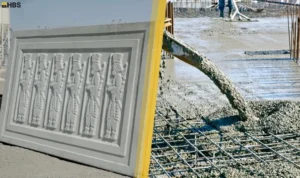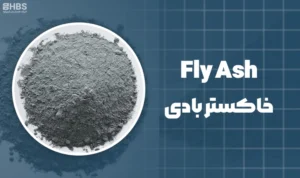Concrete additives are used in the building chemistry industry to enhance the properties of concrete and increase its durability under various conditions. These additives include plasticizers, superplasticizers, water reducers, accelerators, retarders, air-entraining agents, and antifreeze agents. Each of these additives contributes uniquely to improving workability, compressive and tensile strength, environmental resistance, permeability reduction, and setting time of concrete. Additionally, mineral additives like fly ash, silica fume, blast furnace slag, and natural pozzolans play a crucial role in increasing strength and reducing permeability of concrete. These materials improve the mechanical and chemical properties of concrete, extending the lifespan of structures and reducing maintenance and repair costs.
Definition of Concrete and Its Importance in the Construction Industry
Concrete is a material composed of water, cement, sand, and gravel that hardens into a strong and durable substance. Due to its unique properties such as high compressive strength, durability, workability in a plastic state, and reasonable cost, concrete is one of the primary building materials used in construction projects. Common applications of concrete include building bridges, dams, buildings, roads, and foundations.
One of the notable features of concrete is its adaptability to various climatic and environmental conditions, making it an ideal material for constructing different structures in diverse geographic regions. Moreover, the possibility of recycling and reusing concrete makes it a sustainable and eco-friendly option in the construction industry.

Introduction to Concrete Additives and Their Role in Enhancing Concrete Performance
Concrete additives are materials added to the concrete mix to enhance specific properties. These additives can be in liquid or powder form and are typically added in small quantities (less than 5% of the cement weight). Additives are generally classified into chemical and mineral categories, each with various materials possessing unique properties and applications.
Chemical additives include plasticizers, superplasticizers, water reducers, accelerators, retarders, air-entraining agents, and antifreeze agents. These additives improve properties like workability, strength, durability, and setting time by altering the rheological and chemical behavior of concrete.
Mineral additives such as fly ash, silica fume, blast furnace slag, and natural pozzolans enhance the physical and mechanical properties of concrete by modifying its microscopic structure. Using mineral additives can reduce cement consumption, increase strength, and decrease permeability of concrete.
History of Concrete Additives Usage
The use of additives in concrete dates back to ancient times. The first evidence of using additives in concrete is from ancient Rome, where materials like animal blood, milk, and vegetable oils were used to improve workability and strength. Additionally, natural pozzolans (e.g., volcanic ash) were used in constructing water structures like aqueducts and dams to increase concrete’s resistance to water.
Development and Advancement of Concrete Additives Technology in Recent Decades

In the 1950s and 1960s, the first generation of plasticizers and superplasticizers was introduced, allowing for water reduction and improved workability of concrete. These additives enhanced the compressive strength of concrete by reducing the water-to-cement ratio, leading to increased durability and stability of structures.
In the 1970s and 1980s, there was a growing interest in mineral additives like fly ash and silica fume. These materials were used as partial replacements for cement in concrete mixtures, reducing costs and improving mechanical properties and durability. Additionally, the use of air-entraining agents for increasing concrete’s resistance to freeze-thaw cycles became widespread.
In recent decades, new additives such as nanosilica particles, special polymers, and carbon materials have been developed to further enhance concrete properties. These additives alter the microscopic structure of concrete, resulting in increased strength, reduced permeability, and improved durability of structures.
Applications of Concrete Additives in the Building Chemistry Industry
Concrete additives are used in the building chemistry industry for various reasons, including:
- Improving Workability and Flowability of Concrete: Plasticizers and superplasticizers help improve the workability of concrete by reducing its viscosity and increasing its flowability. This makes pouring and compaction easier, especially in complex and dense structures.
- Enhancing Compressive and Tensile Strength of Concrete: Additives like silica fume and superplasticizers increase the compressive and tensile strength of concrete by modifying its internal structure, leading to better load distribution and reduced cracking.
- Increasing Durability and Stability of Concrete in Environmental Conditions: Air-entraining agents create tiny air bubbles in concrete, increasing its resistance to freeze-thaw cycles. This feature is particularly important for structures in cold climates.
- Reducing Permeability and Increasing Resistance to Water and Chemicals: Using mineral additives like fly ash and silica fume decreases concrete’s permeability to water and chemicals, which is crucial for water structures and corrosive environments.
- Adjusting Setting and Hardening Time of Concrete: Accelerators and retarders help regulate the setting time of concrete, providing better control over project execution time.
- Reducing Shrinkage and Cracking of Concrete: Additives like fibers and polymers reduce shrinkage and cracking in concrete by increasing its tensile strength, preventing the formation and propagation of microcracks.
Types of Concrete Additives
Concrete additives are classified into two main categories: chemical and mineral. Each type of additive, with its unique properties and benefits, contributes to enhancing concrete performance and increasing its durability and stability. Below is a detailed examination of each type of chemical and mineral additive, explaining their properties and benefits.
| Types of Concrete Additives | Persian Name | English Name | Reason for Use |
| Chemical Additives | روانکنندهها | Plasticizers | Plasticizers are especially useful in projects requiring high-performance concrete with suitable flowability, such as structures with high rebar density and complex formwork. |
|---|---|---|---|
| فوقروانکنندهها | Superplasticizers | Superplasticizers are used in projects that require high-performance and long-lasting concrete, such as bridges, tunnels, and underground structures. | |
| کاهندههای آب | Water Reducers | Water reducers are used in projects requiring high-strength and durable concrete, such as high-rise buildings and industrial structures. | |
| تسریعکنندهها | Accelerators | Accelerators are used in projects with limited execution time or in cold weather conditions where concrete setting is slow. | |
| کندگیرکنندهها | Retarders | Retarders are used in projects that need more time for concrete pouring, such as large concrete structures or in hot weather conditions. | |
| حبابزاها | Air-Entraining Agents | Air-entraining agents are particularly used in cold regions and for constructing structures exposed to freeze-thaw cycles, such as roads and bridges. | |
| مواد ضد یخ | Antifreeze Admixtures | Antifreeze admixtures are used to increase concrete resistance at low temperatures and prevent it from freezing, allowing for concrete pouring in cold conditions. | |
| Mineral Additives | خاکستر بادی | Fly Ash | Fly ash is used in projects requiring high-strength and durable concrete, such as industrial structures and dams. |
| دوده سیلیسی | Silica Fume | Silica fume is used in projects requiring very high-strength and long-lasting concrete, such as bridges and tunnels. | |
| سرباره کوره بلند | Blast Furnace Slag | Blast furnace slag is used in projects requiring high-strength and durable concrete, such as dams and water structures. | |
| پوزولانهای طبیعی | Natural Pozzolans | Natural pozzolans are used in projects requiring high-strength and long-lasting concrete, such as underground structures and tunnels. |
Chemical Additives
Chemical additives for concrete are materials added to improve various properties of concrete. These additives play an important role in increasing workability, durability, and strength of concrete. The types of chemical additives for concrete are as follows:
Plasticizers

Plasticizers are one of the most common chemical additives used to increase the workability and flowability of concrete. These additives reduce the viscosity of the concrete mix, facilitating better flow and easier placement and compaction.
Properties and Benefits of Plasticizers:
- Increased Workability: Plasticizers reduce internal friction between cement particles, allowing for easier and more uniform movement.
- Reduced Water-Cement Ratio: Increased workability reduces the need for water, leading to a lower water-cement ratio and higher compressive strength of concrete.
- Improved Surface Finish: Plasticizers reduce surface cracking and improve the final surface quality of concrete.
- Reason for Use: Plasticizers are especially useful in projects requiring high-performance concrete with suitable flowability, such as structures with high rebar density and complex formwork.
Superplasticizers

Superplasticizers are an advanced generation of plasticizers that significantly increase the workability of concrete. These materials allow for up to a 30% reduction in water without decreasing the strength of the concrete.
Properties and Benefits of Superplasticizers:
- Significant Increase in Workability: Superplasticizers greatly enhance the flowability of concrete, allowing it to move easily in complex formworks.
- Further Reduction in Water-Cement Ratio: Using superplasticizers reduces the water-cement ratio even more, increasing the compressive strength and durability of concrete.
- Reduced Risk of Bleeding and Segregation: These additives reduce the need for water, decreasing the risk of bleeding and segregation of particles.
- Reason for Use: Superplasticizers are used in projects requiring very high-performance and long-lasting concrete, such as bridges, tunnels, and underground structures.
Water Reducers

Water reducers are additives used to decrease the amount of water required in the concrete mix without negatively affecting its workability. These additives help improve the mechanical properties of concrete.
Properties and Benefits of Water Reducers:
- Reduced Water Consumption: By reducing the required water amount, the water-cement ratio decreases, increasing the compressive strength of concrete.
- Improved Strength: By reducing water, the density and cohesion of cement particles improve, increasing the compressive and flexural strength of concrete.
- Increased Durability: Lowering the water-cement ratio reduces permeability and enhances the durability of concrete against environmental factors.
- Reason for Use: Water reducers are used for projects requiring high-strength and long-lasting concrete, such as high-rise buildings and industrial structures.
Accelerators

Accelerators are materials used to reduce the setting and hardening time of concrete. These additives are particularly useful in cold weather conditions or when project timelines are tight.
Properties and Benefits of Accelerators:
- Reduced Setting Time: Accelerators decrease the initial setting time of concrete, allowing it to harden faster.
- Increased Early Strength: By reducing the setting time, the early strength of concrete is increased, allowing for faster loading on structures.
- Enhanced Productivity: Accelerators improve project execution speed and reduce downtime.
- Reason for Use: Accelerators are used in projects with limited execution time or in cold weather conditions where concrete setting is slow.
Retarders

Retarders are additives used to delay the setting time of concrete. These materials are beneficial in hot weather conditions or for large and complex projects requiring extended working times for concrete placement.
Properties and Benefits of Retarders:
- Delayed Setting: Retarders delay the initial setting time of concrete, allowing for longer placement times.
- Reduced Cracking: By delaying the setting time, the heat of hydration is lowered, reducing the risk of thermal cracking in concrete.
- Improved Final Quality: Retarders help improve the density and uniformity of concrete, enhancing the final quality of structures.
- Reason for Use: Retarders are used in projects requiring extended placement times, such as large concrete structures or in hot weather conditions.
Air-Entraining Agents

Air-entraining agents are additives used to create tiny air bubbles in concrete. These bubbles help increase the concrete’s resistance to freeze-thaw cycles.
Properties and Benefits of Air-Entraining Agents:
- Increased Freeze-Thaw Resistance: The tiny air bubbles act as pressure relievers, preventing cracking in concrete due to freeze-thaw cycles.
- Improved Workability: Air-entraining agents enhance the workability and pumpability of concrete.
- Reduced Cracking: By creating air bubbles, the contraction and expansion of concrete during freeze-thaw cycles are controlled, reducing cracking.
- Reason for Use: Air-entraining agents are especially used in cold regions and for structures exposed to freeze-thaw cycles, such as roads and bridges.
Antifreeze Admixtures
Antifreeze admixtures are additives used to increase the resistance of concrete at low temperatures and prevent it from freezing. These materials enable concrete placement in cold conditions.
Properties and Benefits of Antifreeze Admixtures:
- Prevention of Concrete Freezing: Antifreeze admixtures lower the freezing point of water in the concrete mix, preventing it from freezing in low temperatures.
- Increased Strength in Low Temperatures: These admixtures help increase the strength and durability of concrete in cold conditions.
- Possibility of Concrete Pouring in Winter: Antifreeze admixtures enable the execution of concrete pouring projects during the winter and in cold regions.
- Reason for Use: Antifreeze admixtures are used for projects that require concrete pouring at low temperatures and in cold weather conditions, such as underground structures and structures located in cold regions.
Mineral Admixtures
Mineral admixtures are added to the mix to improve the mechanical properties and durability of concrete. These admixtures include materials derived from natural sources or industrial processes and are used in the concrete industry due to their special properties.
Fly Ash

Fly ash is a mineral admixture produced from the combustion of coal in thermal power plants and is used as a pozzolan in concrete. This material helps improve the mechanical properties and durability of concrete.
Properties and Benefits of Fly Ash:
- Increased Strength: Fly ash increases the compressive and flexural strength of concrete by enhancing pozzolanic reactions.
- Reduced Permeability: This material reduces the permeability of concrete to water and chemicals.
- Improved Workability: Fly ash helps improve the workability and flow of concrete.
- Reason for Use: Fly ash is used in projects that require high-strength and long-lasting concrete, such as industrial structures and dams.
Silica Fume

Silica fume is a very fine-grained mineral material obtained from the production of silicon metal. This material is used as an admixture in concrete, significantly increasing its strength and reducing its permeability.
Properties and Benefits of Silica Fume:
- Increased Strength: Silica fume significantly enhances the compressive and flexural strength of concrete through pozzolanic reactions.
- Reduced Permeability: This material reduces the permeability of concrete to water and chemicals.
- Increased Durability: Silica fume helps increase the durability and stability of concrete in various environmental conditions.
- Reason for Use: Silica fume is used in projects that require very high-strength and long-lasting concrete, such as bridges and tunnels.
Blast Furnace Slag

Blast furnace slag is a mineral material obtained from iron smelting in blast furnaces and is used as a partial replacement for cement in concrete mixtures.
Properties and Benefits of Blast Furnace Slag:
- Increased Strength: Blast furnace slag enhances the compressive strength of concrete by improving the density and cohesion of cement particles.
- Reduced Permeability: This material reduces the permeability of concrete to water and chemicals.
- Increased Durability: Blast furnace slag helps increase the durability and stability of concrete in various environmental conditions.
- Reason for Use: Blast furnace slag is used in projects that require high-strength and long-lasting concrete, such as dams and water structures.
Natural Pozzolans

Natural pozzolans are materials that include volcanic ash and active clays, and are used as admixtures in concrete.
Properties and Benefits of Natural Pozzolans:
- Increased Strength: Natural pozzolans enhance the compressive and flexural strength of concrete through pozzolanic reactions.
- Reduced Permeability: These materials reduce the permeability of concrete to water and chemicals.
- Increased Durability: Natural pozzolans help increase the durability and stability of concrete in various environmental conditions.
- Reason for Use: Natural pozzolans are used in projects that require high-strength and long-lasting concrete, such as underground structures and tunnels.
Applications of Concrete Admixtures
Concrete admixtures are vital components in modern concrete mixtures, widely used to enhance the properties of concrete in various construction projects. Each type of admixture adds specific characteristics to the concrete, leading to improved overall performance under different conditions. Below, we review the various applications of concrete admixtures and explain the benefits of each.
| Application | Benefits | Example |
| Increase Concrete Workability and Flow |
|
|
| Improve Compressive and Tensile Strength of Concrete |
|
|
| Increase Concrete Durability and Stability Against Environmental Conditions |
|
|
| Reduce Permeability and Increase Resistance to Water and Chemicals |
|
|
| Adjust Setting Time and Hardening of Concrete |
|
|
| Reduce Shrinkage and Cracking of Concrete |
|
|
Increase Concrete Workability and Flow
- One of the main applications of concrete admixtures is to increase the workability and flow of the concrete mix. This feature is especially important in projects that require concrete with high flowability. Plasticizers and superplasticizers are widely used for this purpose.
Benefits:- Ease of Concrete Placement: Increased flowability makes concrete placement in complex forms and areas with high reinforcement density easier.
- Reduced Labor Force: Flowable concrete requires less effort for leveling and compaction, leading to reduced labor costs.
- Reduced Segregation: Increased workability reduces the risk of aggregate segregation and bleeding, resulting in improved final concrete quality.
Examples:
Construction of bridges and tunnels with complex forms
Projects using sliding or climbing formwork
Improve Compressive and Tensile Strength of Concrete
Various admixtures such as superplasticizers, silica fume, and fibers help improve the compressive and tensile strength of concrete. These materials enhance the cohesion and internal bonding in concrete, increasing its resistance to compressive and tensile loads.
Benefits:
Increased Service Life of Structures: With increased strength, structures have greater ability to withstand heavy loads and harsh environmental conditions.
Improved Performance Under Dynamic Loads: Higher strength helps improve the performance of concrete under dynamic loads such as earthquakes and wind.
Examples:
High-rise buildings and towers
Bridges and tunnels in earthquake-prone areas
Increase Concrete Durability and Stability Against Environmental Conditions
Concrete durability is influenced by various environmental conditions such as humidity, temperature, and chemicals. Different admixtures such as air-entraining agents, silica fume, and natural pozzolans help increase concrete durability.
Benefits:
Resistance to Freezing and Thawing: Air-entraining agents create fine air bubbles in concrete, increasing its resistance to freeze-thaw cycles.
Increased Resistance to Corrosion: Mineral admixtures like silica fume help reduce permeability and increase concrete’s resistance to corrosive chemicals.
Examples:
Concrete structures in cold and humid regions
Marine and harbor structures
Reduce Permeability and Increase Resistance to Water and Chemicals
One of the most important applications of concrete admixtures is to reduce permeability and increase concrete’s resistance to water and chemicals. This feature is especially important in constructing structures exposed to water and chemicals.
Benefits:
Reduced Risk of Cracking: Reduced permeability decreases the risk of cracking due to water absorption and expansion.
Increased Service Life of Structures: Concrete with lower permeability has greater durability against corrosive environmental conditions.
Examples:
Construction of dams and water reservoirs
Underground structures and tunnels
Adjust Setting Time and Hardening of Concrete
Adjusting the setting time of concrete is possible using accelerators and retarders. These admixtures help control the setting and hardening time of concrete, suitable for various working conditions.
Benefits:
Increased Construction Speed: Accelerators help reduce setting time and increase construction speed.
Control of Working Time: Retarders increase the working time of concrete, making them suitable for large and complex projects.
Examples:
Concrete pouring in cold weather conditions using accelerators
Concrete pouring in large and complex projects using retarders
Reduce Shrinkage and Cracking of Concrete
Shrinkage and cracking are common problems in concrete that can lead to reduced strength and durability of structures. Various admixtures such as fibers and expansive agents help reduce these problems.
Benefits:
Reduced Cracking: By reducing shrinkage and expansion, the risk of cracking is minimized.
Increased Uniformity: Admixtures help improve the uniformity and density of concrete, resulting in increased final quality.
Examples:
Structures with thin sections and susceptible to cracking
Projects requiring long-term durability and stability
Benefits of Concrete Admixtures and Their Role in Construction

Concrete admixtures not only help improve the performance and durability of concrete but also play a crucial role in reducing construction costs. These cost reductions can be achieved directly through reduced material consumption and increased construction speed or indirectly through improved quality and reduced maintenance and repair needs.
Reduce Cement and Raw Material Consumption
Using mineral admixtures such as fly ash and silica fume can reduce cement consumption. These materials replace a portion of the cement in the concrete mix, helping to reduce the costs associated with raw materials.
Benefits:
Reduced Raw Material Costs: Replacing a portion of the cement with mineral admixtures reduces overall raw material costs.
Reduced Environmental Impact: Reduced cement consumption leads to lower carbon dioxide emissions and environmental impact.
Examples:
Use of fly ash in large construction projects
Use of silica fume in structures requiring high strength
Increase Construction Speed and Reduce Project Time
Accelerators and superplasticizers help increase construction speed and reduce project time. These materials increase the setting speed and improve concrete workability, enabling faster project execution.
Benefits:
Reduced Project Execution Time: Using accelerators reduces the setting time of concrete, enabling faster execution of subsequent project stages.
Reduced Labor Costs: Increased construction speed reduces the need for labor and related costs.
Examples:
Projects requiring rapid completion, such as bridges and tunnels
Structures with limited execution time, such as temporary buildings
Improve Quality and Reduce Maintenance and Repair Needs
Concrete admixtures improve the mechanical properties and durability of concrete, reducing the need for maintenance and repair of structures. These admixtures increase strength, reduce permeability, and enhance concrete durability, extending the service life of structures.
Benefits:
Reduced Maintenance and Repair Costs: Improved concrete quality reduces the need for frequent repairs, lowering long-term maintenance costs.
Increased Service Life of Structures: Increased concrete strength and durability extend the service life of structures, reducing costs associated with replacement and reconstruction.
Examples:
Marine and harbor structures requiring high durability
Industrial and commercial projects requiring reduced maintenance costs
Environmental Impact of Concrete Admixtures
Concrete admixtures, in addition to their numerous benefits in improving concrete properties and performance, also have diverse environmental impacts. These impacts can be both positive and negative and can vary depending on the type of admixture and its usage. This section examines the positive and negative environmental impacts of admixtures and methods for reducing negative impacts and increasing environmental sustainability.
Positive and Negative Environmental Impacts of Admixtures
✅ Reduced Raw Material Consumption: Using mineral admixtures such as fly ash and silica fume as partial replacements for cement in concrete reduces cement consumption. This reduction in cement consumption helps lower raw material extraction and carbon dioxide emissions in the cement production process.
✅ Increased Durability of Structures: Admixtures improve the mechanical properties and durability of concrete, increasing the service life of structures. Durable structures require less frequent maintenance, reducing resource consumption and construction waste generation.
✅ Reduced Permeability and Increased Resistance to Chemicals: Admixtures such as silica fume and natural pozzolans reduce concrete permeability and increase resistance to corrosive chemicals. These properties reduce the need for protective materials and chemical coatings, which can have negative environmental impacts.
❌ Emission of Chemicals: Some chemical admixtures may contain harmful substances that can enter the environment during production, transportation, and use. These substances can contribute to water, soil, and air pollution.
❌ High Energy Consumption: Producing some admixtures, especially chemical ones, requires high energy consumption. This energy consumption leads to increased greenhouse gas emissions and associated environmental impacts.
❌ Health Impacts: Some concrete admixtures may have negative health impacts. These impacts can occur through direct contact with chemicals or the release of harmful gases and particles into the air.
Methods for Reducing Negative Impacts and Increasing Environmental Sustainability
Use of Sustainable Materials: Choosing and using mineral admixtures such as fly ash, silica fume, and blast furnace slag, which are derived from industrial waste and by-products, can help reduce environmental impacts.
Improving Production Processes: Improving the production processes of chemical admixtures to reduce energy consumption and emissions of harmful substances can help minimize the environmental impacts of these admixtures. Using renewable energy and advanced technologies can be effective in this regard.
Development and Implementation of Environmental Regulations: Developing and implementing stringent environmental regulations for the production, transportation, and use of concrete admixtures can help reduce their negative impacts on the environment. These regulations should include requirements for controlling the emission of harmful substances and managing production waste.
Research and Innovations: Investing in research and development of new innovations for producing concrete admixtures with lower environmental impacts and higher efficiency can help reduce negative impacts. These innovations may include producing bio-based admixtures and using recycled materials.
Education and Awareness: Educating and raising awareness among producers and consumers about the environmental impacts of concrete admixtures and methods for reducing these impacts can play an important role in increasing environmental sustainability.
Standards and Regulations for Concrete Admixtures

Standards and regulations related to concrete admixtures play a crucial role in ensuring the quality, safety, and performance of these materials in construction. These standards and regulations help manufacturers and consumers use concrete admixtures with greater confidence and minimize their negative impacts.
Introduction to International and National Standards for Concrete Admixtures
ASTM (American Society for Testing and Materials) Standards: ASTM is one of the most important international standards organizations that sets regulations and requirements for concrete admixtures. These standards include tests and quality criteria for various types of concrete admixtures.
EN (European Norm) Standards: EN standards also set a series of regulations and requirements for concrete admixtures across Europe. These standards help manufacturers and consumers ensure the quality and performance of concrete admixtures.
National Standards of Iran (ISIRI): In Iran, national standards for concrete admixtures are established by the Institute of Standards and Industrial Research of Iran (ISIRI). These standards include the necessary requirements and tests to confirm the quality of admixtures in construction projects.
Requirements and Tests for Quality Assurance of Admixtures
Chemical Tests: Chemical tests are conducted to determine the chemical composition of concrete admixtures and ensure their compliance with relevant standards. These tests include various analyses to identify harmful substances and determine material purity.
Physical Tests: Physical tests are conducted to examine the mechanical properties of concrete admixtures. These tests include measuring compressive, tensile, and flexural strengths, as well as the durability of concrete with different admixtures.
Performance Tests: Performance tests are conducted to evaluate the impact of concrete admixtures on workability, setting time, flowability, and permeability of concrete. These tests help manufacturers and consumers ensure the optimal performance of concrete admixtures.
Environmental Tests: Environmental tests are conducted to assess the impact of concrete admixtures on the environment. These tests include evaluating the emission of harmful substances and the environmental impact of producing and using concrete admixtures.
Quality Certifications: Concrete admixtures must obtain quality certifications from reputable organizations and centers. These certifications indicate the compliance of admixtures with relevant standards and regulations and their quality and safety.
Conclusion
In this article, we comprehensively reviewed various types of concrete admixtures and their roles in the building chemistry industry. Concrete admixtures, whether chemical or mineral, play a vital role in enhancing the properties and performance of concrete in construction projects. Proper use of these admixtures can result in high-performance, durable, and extremely strong concrete that performs well in different environmental conditions. Selecting the appropriate admixture based on the specific needs of each project is very important and can make a significant difference in the quality and longevity of structures.
For free consultation and more information on various types of concrete admixtures and how to use them in different projects, you can contact the experts at Hamyar Beton Shirkooh Yazd. Our team is ready to assist you in selecting the best admixtures and providing optimal solutions to improve concrete performance.
